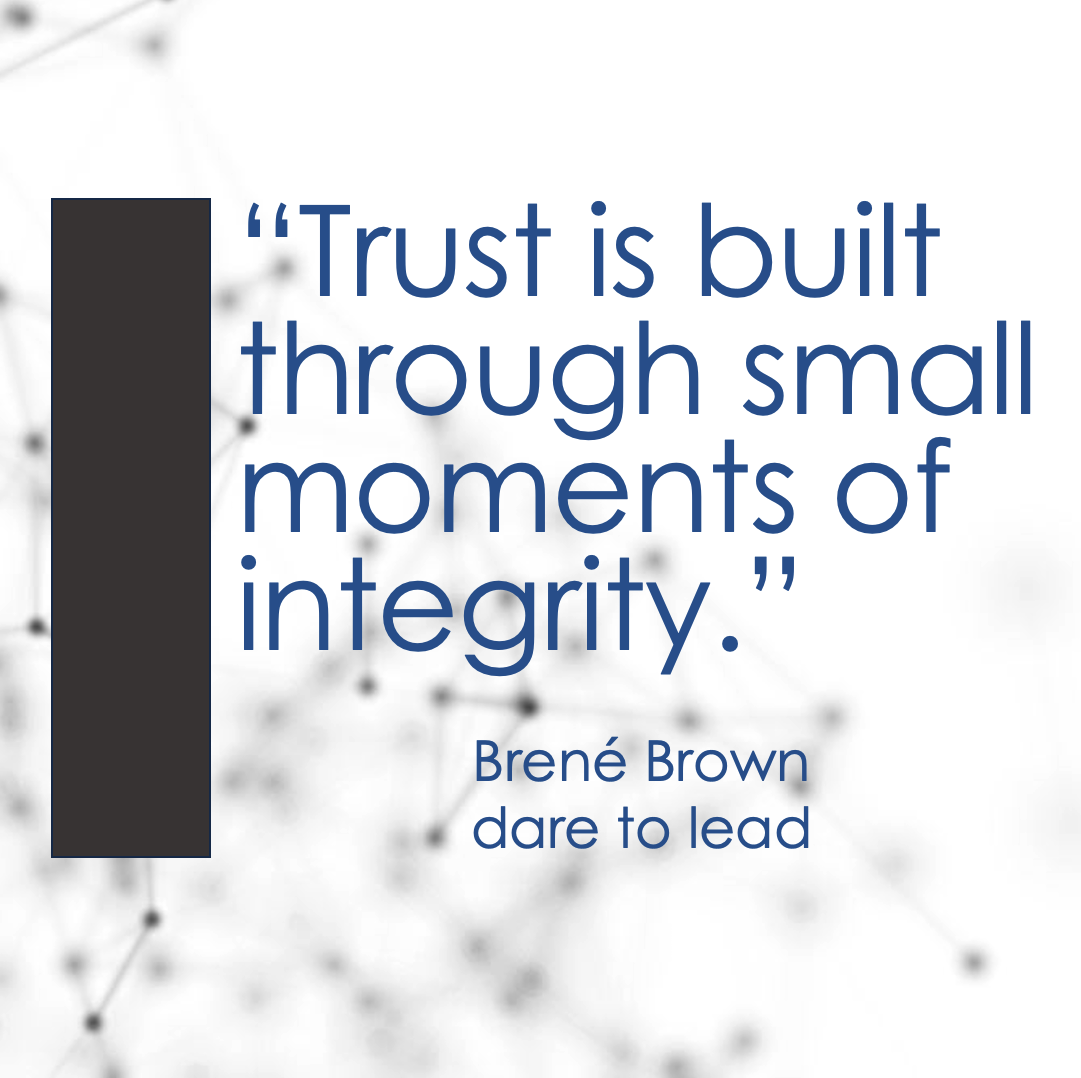The What, Why and How of Vulnerable Leadership
/Researcher, speaker, New York Times bestseller Brené Brown is an expert on vulnerable leadership and the importance for us all to have courage, put ourselves out there and show more emotion. She – and others I’ll mention throughout this article write and speak about how vulnerability and building a culture of creativity, trust, and collaboration is important for organizations, leaders and of course employees to be successful and engaged.
Let’s start this discussion by exploring what vulnerability is. Vulnerability may look different for each of us. It depends on our personalities, our upbringing, our experiences and so much more. For some, vulnerability can mean fearing not always having the answers. It can mean searching for the courage to ask others for help. We can also feel vulnerable when we [should] say, “I was wrong” or “I made a mistake.” And I bet all of us have felt vulnerable when we’ve entered a room and discovered we don’t know anyone and/or don’t see anyone who looks like us.
So yes, there are many ways to feel vulnerable. At this point, as a leader you may be thinking, “If you want to see vulnerable – ask me to add this to my plate. How can I possibly find time in my already far too long To Do list to add one more thing – especially the idea of vulnerability?” And yet you still want to be the best leader you can be for yourself and your team. This is what makes you a terrific leader, even if you don’t [yet] have a formal position as a leader. So, what I suggest is that as you take a few minutes to read this article, ask yourself, “Is there one small step I can take?” And as you do this I invite you to think of vulnerability from a position leadership strength, not a weakness; an example of positivity and opportunity.
Now that we have a shared the idea to see vulnerability as a strength, let me outline two more important areas we will explore in the next few minutes:
The positive attributes of vulnerability.
How to build a culture that is safe and where everyone can be vulnerable.
The power of vulnerability in leadership. How great leaders see vulnerability as a strength, not a weakness.
You and I both know that leaders don’t have all the answers.
Success in today’s high tech, fast paced economy requires creativity and innovation at all levels of the organization. It also requires alignment across the team on our shared vision, mission and values (which I recommend be fine-tuned every year). For creativity and innovation to exist, every team and every company must work together towards creating a culture where people feel welcome to be themselves and show their emotions to their team, coworkers, clients, and suppliers. This doesn’t happen by accident.
When we believe we can be authentic at work, we are able to help build inspired solutions that will make us all proud and successful. The best leaders aren’t afraid to be vulnerable. Leaders who see vulnerability as a strength are able to build teams who are willing to dare greatly as Brené Brown might say. By embracing vulnerability, leaders create an environment that nurtures trust, opens channels of communication and listens to new ideas – from everyone. This is where a leader’s real strength can flourish as they help others collaborate and share their expertise.
In contrast, when leaders try to be all knowing and all-powerful they are not protecting themselves. Instead, they are putting their longer-term success at risk as well as the future success of their team.
How to build a culture that is safe and where everyone can be vulnerable?
From Brené Brown to perhaps the leading expert on Emotional Intelligence Dr. Daniel Goleman, to motivational speaker and author Simon Sinek to Canadian author focused on transformational leadership, social collaboration, and communication Celine Schillinger, they all agree great leaders create an environment of respect, safety, and curiosity that teams trust.
The power of vulnerability in leadership cannot be overstated. And while this all sounds amazing, you and I have years of pre-programing within our communities / cultures that has told us that vulnerability means weakness. It will take effort for you to unlearn some of our less helpful biases and past lessons and decide to forge a new path that sees vulnerability and showing emotion as strengths and opportunities. It’s time to embrace new ideas and new voices that will create relevant, timely and collaborative solutions that also help us feel engaged and proud.
To build a culture where everyone can be vulnerable, everyone on the team must be certain they are allowed to be creative and to start sentences with the words, “What if we were to…” as they begin to share inspired, improvised, half-baked ideas. Here are a few examples how you can start building a culture of trust.
Get to know each other. You don’t have to become best friends, but start seeing people as more than a j.o.b. Explore what you have in common. Do you have pets, a summer cottage, traveled through Greece? Knowing someone is a good way [not a guaranteed way] to begin trusting someone.
Set an example when you are not doing well… when you are struggling. For example, if you are exhausted, frustrated or stressed, it’s fair to send someone else to a meeting on your behalf because you need some down-time. Delegating has the bonus of letting that person know you trust their ability to stand-in for you. Another example is asking for help if you are struggling with a task. In this example you are proving that asking for help is not only OK, but expected. And the bonus here is that it may give a junior employee a feeling of pride to be able to mentor you.
If you see someone else feeling vulnerable or attacked, help them! They may not feel they can stand up for themselves so do it for them. This demonstrates you are paying attention and that you care. And the people who see you do this will know it is OK to stand up for someone else as well.
Always stand up for the organizational values. As I shared earlier, your organizational values must be respected by all. And everyone in leadership positions must set the example. If leaders ignore shared values, they are telling others it’s OK for them to ignore them as well and that this jeopardizes team alignment, efficiencies and so much more – including perhaps the importance of building / honoring respect and trust.
“Leadership is not about being in charge. It's about taking care of those in your charge.” Simon Sinek
And while leaders must set the intention, it is all of our responsibility to build a trusting, vulnerable, safe workspace. The following are guideline examples for you to consider and expand upon:
Cultivate openness where everyone knows that when they share ideas, observations and opinions that they will be heard and valued.
Know that it’s unacceptable to not listen to others (and to learn).
Never joke, tease or gossip about someone elses expense. Everyone must know there is no risk of being made to feel stupid or embarrassed.
Acknowledge that leaders likely have insight into broader goals and have greater decision-making responsibility and therefore may make decisions we don’t fully understand or agree to… but must support.
Know our worth is not placed on whether our ideas are accepted.
Know that we all make mistakes, and we will use them as an opportunity to learn, not an opportunity to judge, accuse or demonize us.
Know that while we share our ideas, we must also know they may not be fully adopted but may spark other ideas.
Agree that if we have an idea or suggestion that is out of scope of the immediate topic under discussion that it might be best to arrange a smaller one-on-one meeting with our leader or one of our co-workers and start a discussion there. Staying on-topic during a meeting is also important.
All this to say, you can achieve honest, respectful relationships with your whole team when you agree to how you will treat each other. When team members can be vulnerable with each other, creativity and innovation are enhanced,.
Share Without Oversharing
Privacy and boundaries still exists in a vulnerable culture.
Questions many leaders ask themselves when practicing vulnerability is, “How do I embrace vulnerability without overdoing it and oversharing to the point of making someone uncomfortable — regardless of any positive intentions?”
A team that fully embraces vulnerability must also have an open discussion and shared agreement / recognition that we are all individuals with our own sensitivities and personalities. We must respect that someone may feel uncomfortable or vulnerable even though we don’t. It’s also true that some things are private – not everything about us needs be shared at work. The vulnerability we share at work doesn’t have to be the same vulnerability we share with our family or partner.
My suggestion is that if you are concerned you are oversharing or if you are worried your idea may trigger a sensitivity for someone on your team, this may be the perfect time to share the idea in a closed, one-on-one meeting with your superior. And if you are a leader who has already navigated this, I thank you for having your empathy and edit features turned on. Well done!
One last thing before I close. If you are wondering, “What if Bruce hasn’t done the task he said he would or is not being a team player. Shouldn’t I bring that forward?” To this, I say absolutely – but is that about creativity and a new idea or is that about Bruce putting the team and project in jeopardy? To me it sounds like the latter which suggests it is a conversation you should bring up with your leader or one of your co-workers in a private meeting – Bruce should not be made to feel vulnerable in that situation. Remember, for vulnerability to become a positive in your team it must be supported by trust and respect.
Conclusion
It is time for vulnerability to be part of our workplace culture; to show our emotions to our team and coworkers, our clients and suppliers. In recent years vulnerability for leaders and their teammates of all genders and generations has grown to become culturally acceptable, welcomed and even encouraged. Millennials and Gen Z especially are more comfortable asking for time to manage caregiver and mental health concerns. And lets face it, Millennials and Gen Z are now the dominant populations in our workforce.
If you’ve studied ‘Courageous Leadership’ and have been thinking of it as you read this article, that makes sense to me. Like courageous leadership, being a leader who begins developing a culture of vulnerability often starts with one or two small acts of courage. You can be certain that the best leaders aren’t afraid to be vulnerable. As you evolve down this path, and I imagine from time to time feel outside your comfort zone, I do hope you take pride in the steps you take, how you’ve evolved – grown during the process and how you now know you’ve have supported courageous leadership in your own way.
“Daring leaders work to make sure people can be themselves and feel a sense of belonging.” Brené Brown
When courageous leaders begin to demonstrate vulnerability and trust in their team, something truly special happens. I invite you to build a culture of collaboration, creativity and high employee engagement.
Leadership is a journey, not a destination.
Thank you for spending time with me today and reading ‘The What, Why and How of Vulnerable Leadership’.
Bruce
Learn More About Bruce Mayhew
Toronto corporate trainer and executive coach Bruce Mayhew Consulting is in the people business… it just so happens that training and/or executive coaching is involved. Let us help you improve your productivity and employee engagement.
To learn more about how leadership training can to improve your skills call us at 416.617.0462.
Bruce Mayhew Consulting's most popular programs are Email Etiquette Training, Difficult Conversations, Generational Differences, Leadership Skills Training and Time Management Training
Related Workshops That Drive Business Success
What Is Servant Leadership?
Toronto based corporate trainer and executive coach Bruce Mayhew Consulting proudly offers leadership training and professional development.



